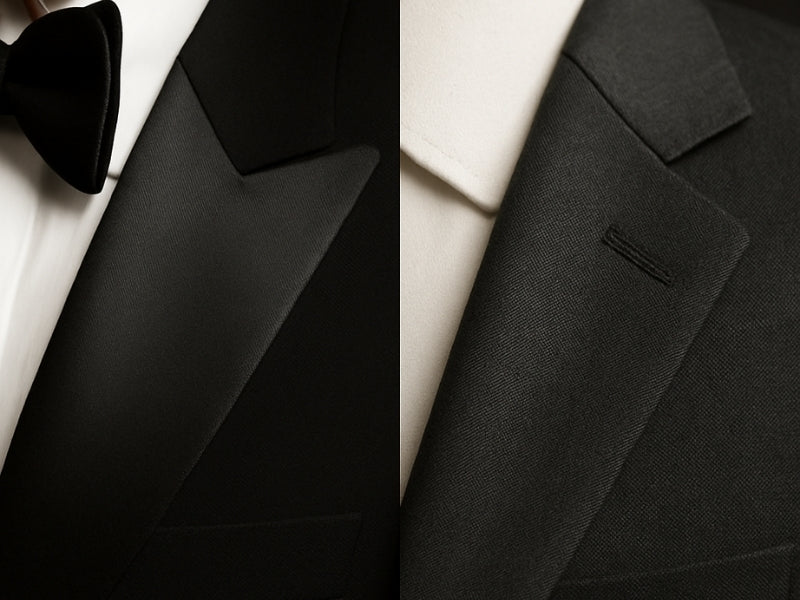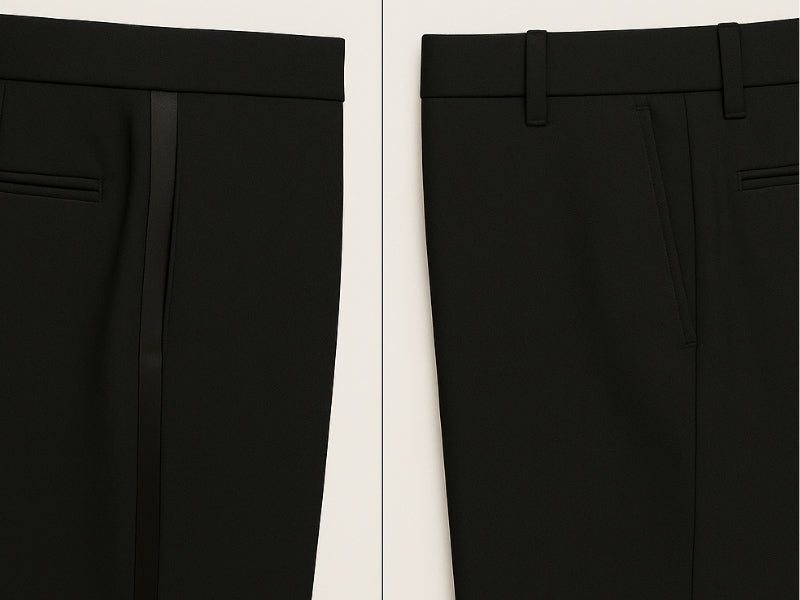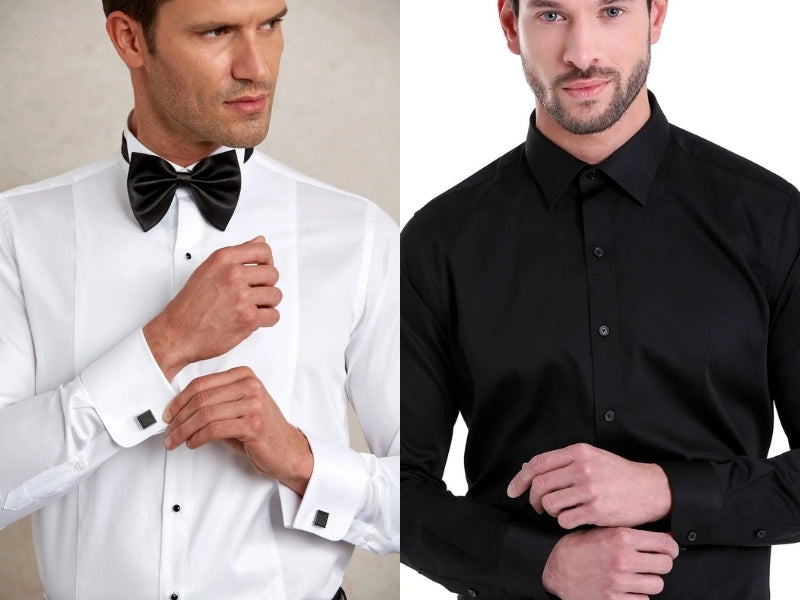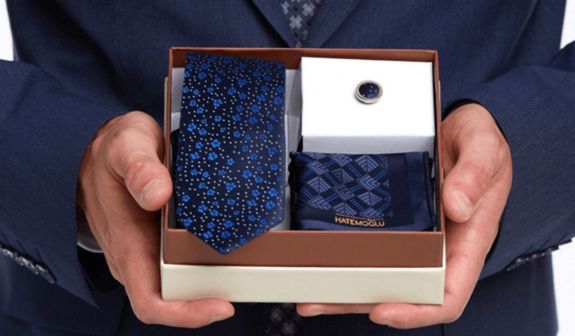
Choosing between a tuxedo and a men's suit can make or break your formal appearance. While both garments may look similar at first glance, their distinct features, appropriate occasions, and styling requirements set them worlds apart. Understanding these key differences will ensure you always make the right sartorial choice for any event.

What Is a Tuxedo?
A tuxedo represents the pinnacle of formal menswear elegance. This sophisticated garment is characterized by its distinctive satin details, including satin-faced lapels, satin-covered buttons, and a satin stripe running down the outer seam of the trousers. Traditionally worn with a crisp white dress shirt, bow tie, and patent leather shoes, the tuxedo is synonymous with black-tie events and evening formal occasions.
The classic tuxedo comes in midnight black or navy blue, designed to create a sleek, uniform silhouette that exudes sophistication. Unlike regular suits, tuxedos follow strict formal wear conventions that have remained largely unchanged for over a century.
What Is a Suit?
A suit offers versatility and adaptability for various occasions, from boardroom meetings to weekend social events. Unlike tuxedos, suits feature lapels, buttons, and trousers made from the same fabric, creating a cohesive yet less formal appearance. The men's suit can be worn with or without a tie, depending on the desired level of formality.
Suits come in an extensive range of colors, patterns, fabrics, and styles, offering endless customization possibilities to match personal preferences and occasions. From pinstripes to solids, wool to linen, suits provide the foundation for countless styling combinations.
Key Differences Between Tuxedos and Suits
| Feature | 🤵 Tuxedo | 👔 Suit |
|---|---|---|
| 👔 Lapels | Satin-faced lapels | Same fabric as jacket |
| 🔘 Buttons | Satin-covered buttons | Regular fabric buttons |
| 👖 Trousers | Satin stripe (braid) | No stripe, belt loops |
| 👕 Shirt | White dress shirt only | Various colors & patterns |
| 🎨 Colors | Black or midnight navy | Wide color range |
| 🎀 Tie Style | Bow tie required | Necktie or bow tie |
| 👞 Shoes | Black patent leather | Various leather styles |
| 🌟 Occasions | Black-tie, formal evening | Business, semi-formal |
Satin Details & Lapels
The most obvious distinction lies in the lapel treatment. Tuxedo lapels feature satin facing that creates a subtle sheen and formal appearance. These satin lapels can be peaked, shawl, or notched, but they always maintain that distinctive glossy finish. Suit lapels, conversely, are made from the same fabric as the jacket body, creating a more uniform and understated look.

Buttons & Closures
Tuxedo buttons are typically covered in satin to match the lapel facing, creating a seamless formal aesthetic. Many tuxedos feature horn or mother-of-pearl buttons for added elegance. Suit buttons are usually made from plastic, horn, or metal, matching the overall fabric color and texture of the garment.

Trousers & Accessories
Tuxedo trousers are distinguished by their satin stripe (called a "braid") running down the outer seam of each leg. This detail complements the jacket's satin elements and eliminates the need for a belt. Suit trousers lack this stripe and typically include belt loops, offering more casual versatility.

Shirts & Collars
Tuxedo shirts are traditionally white with wing-tip or spread collars designed to showcase bow ties. They often feature pleated fronts, French cuffs for cufflinks, and sometimes bib fronts for ultra-formal occasions. Suit shirts offer much more variety in colors, patterns, and collar styles, allowing for greater personal expression.

Color & Fabric Choices
Tuxedos traditionally come in black or midnight navy, though modern variations include other dark colors. The fabric is typically wool, often with a subtle sheen. Suits offer unlimited color and pattern options, from conservative navy and gray to bold plaids and seasonal hues, in fabrics ranging from lightweight cotton to heavy tweeds.
Fit & Structure
Tuxedos typically feature a more structured, tailored fit with defined shoulders and a nipped waist to create an elegant silhouette. Suits offer various fit options from slim to relaxed, allowing for different body types and style preferences.
When Should You Wear a Tuxedo or Suit?
Understanding the appropriate occasions for each garment is crucial for making the right impression. The choice between a tuxedo and men's suit often depends on the event's formality level, time of day, and specified dress code requirements.
Formal Events & Black-Tie Affairs
Black-tie events explicitly require tuxedos. These include charity galas, award ceremonies, opera premieres, and upscale evening events. When an invitation specifies "black-tie," there's no substitute for a proper tuxedo. Wearing a suit to a black-tie event, regardless of how expensive or well-tailored, violates dress code etiquette.
Weddings & Ceremonies
For weddings, the choice depends on the time and formality level. Evening weddings, particularly those in upscale venues, often call for tuxedos for the groom and groomsmen. Daytime weddings typically favor suits, which offer more flexibility in color coordination and seasonal appropriateness.
Business & Professional Settings
The men's suit reigns supreme in business environments. From job interviews to board meetings, suits project professionalism and competence. Navy, charcoal, and gray suits form the foundation of any professional wardrobe, offering versatility across various corporate settings.
Semi-Formal & Social Events
Cocktail parties, dinner dates, theater performances, and social gatherings typically call for suits rather than tuxedos. Suits can be dressed up or down depending on shirt, tie, and accessory choices, making them ideal for events where the dress code falls between casual and formal.
Styling Tips for Tuxedos and Suits
Mastering the art of formal wear styling goes beyond simply choosing the right garment. Whether you're wearing a tuxedo for a black-tie event or a men's suit for business occasions, proper styling techniques can elevate your appearance and ensure you always look polished and confident.
Choosing the Right Fit
Proper fit is non-negotiable for both garments. Tuxedos should fit close to the body without restricting movement, with jacket shoulders sitting naturally and trouser length hitting the shoe with minimal break. Suits offer more flexibility in fit options, but the principles remain the same: shoulders should align, sleeves should show a quarter-inch of shirt cuff, and trousers should break slightly on the shoe.
Coordinating Colors & Patterns
Tuxedo coordination is straightforward: black or navy tuxedo with white shirt and black accessories. Suit coordination offers more creative freedom. Master the basics first - navy suit with light blue shirt, gray suit with white or light pink shirt - then experiment with patterns and textures while maintaining color harmony.
Accessorizing for Impact
Tuxedo accessories are traditional: black bow tie, white pocket square, black patent leather shoes, and silver or gold cufflinks. Suit accessories allow for more personality: experiment with tie colors and patterns, pocket square styles, belt and shoe combinations, and watch choices to express individual style.

See also : How to Choose the Right Accessories for Men: A Style Manual
Common Mistakes to Avoid
Never wear a regular necktie with a tuxedo - it's a fundamental formal wear violation. Avoid brown shoes with tuxedos; stick to black patent leather or highly polished black leather. For suits, ensure belt and shoe colors coordinate, and avoid over-accessorizing with too many competing patterns or colors.
Factors to Consider When Choosing
When choosing between a tuxedo and men's suit, consider the event's formality level, time of day, specified dress code, and your personal comfort with formal wear conventions. Evening events lean toward tuxedos, while daytime occasions favor suits. When in doubt, err on the side of formality - it's better to be slightly overdressed than underdressed.
The investment in quality formal wear pays dividends in confidence and appearance. Whether you choose the timeless elegance of a tuxedo or the versatile sophistication of a suit, proper fit, quality construction, and appropriate styling will ensure you always make a distinguished impression.
Building a complete formal wardrobe should include both options: a classic black tuxedo for formal evening events and at least one well-fitted navy or charcoal suit for business and semi-formal occasions. This foundation provides the flexibility to dress appropriately for any situation while maintaining impeccable style standards.
Remember: The key to formal wear success lies not just in choosing the right garment, but in wearing it with confidence and understanding its proper context. Master these fundamentals, and you'll never question your formal wear choices again.











